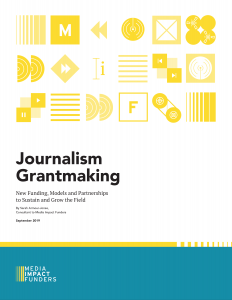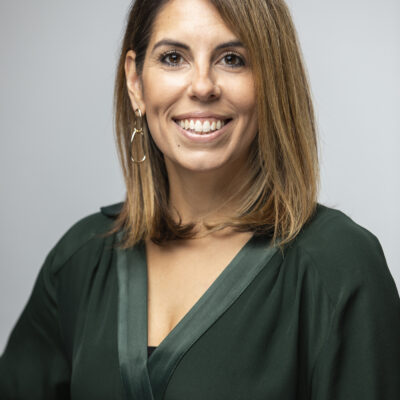
This post was updated on Nov. 18, 2019.
We’ve come a long way since 2001, when a handful of journalism funders got together to compare notes. (We’re looking at you, Jon Funabiki, Vivian Vahlberg and Eric Newton!)
Last week, we convened more than 100 funders for our annual gathering to discuss some of the most pressing issues facing journalism today.
Our host for the meeting, the Kaiser Family Foundation, knows a thing or two about media funding. Housed within the foundation is the editorially independent Kaiser Health News, the largest health newsroom in the United States. We were fortunate to hear from Drew Altman, the foundation’s president and CEO.
“Our basic idea was to build an organization with an independent voice for people by finding and presenting the facts and truth in the healthcare system, and acting as a counterweight to the money and politics in health,” Altman said of Kaiser’s commitment to health journalism.
It was the perfect opening for this crowd—which represented our largest journalism funder gathering to date—who came together for two days of conversations about funder collaborations, supporting diversity, equity and inclusion efforts in journalism, strategies to combat news deserts, and much more.
At the end of the first day, we made our way over to Public House inside of Oracle Park, home of the San Francisco Giants. (It was also Game 6 of the World Series, so you can imagine our excitement that evening.) At dinner, we heard from Anna Sale, who talked about her WNYC podcast “Death, Sex & Money,” which aims to open up our ears and hearts to life’s most difficult questions. We recorded her remarks, which you can watch here:
We were also fortunate to have Eric Newton with us, one of the founding members of our journalism funders group, who attended with Bay City News Foundation founder Katherine Rowlands. The Bay City News Foundation is the first recipient of the newly announced Newton-Hogan Fund, which aims to “turbocharge” the internship program at Bay City News.
Here’s some of what we learned in San Francisco last week:
Collaborations are difficult, but they can produce powerful, community centered journalism.
In a panel discussion led by Jon Funabiki, executive director of Renaissance Journalism, we learned that in the Bay Area, news outlets are turning to collaborative models in an effort to do more with fewer resources. For example, we heard about “Who Owns Silicon Valley?”—a multi-newsroom investigative reporting project produced by Reveal at the Center for Investigative Reporting, KQED, The Mercury News, NBC Bay Area, Renaissance Journalism and Telemundo 48 Área de la Bahía. The collaboration is part of Reveal’s Local Labs initiative, which supports investigative collaborations across the country. The series stemmed from a year-long analysis of 500,000 county records from Santa Clara’s Property Assessor’s office from 2018 and shows which organizations and corporations own the most land and control the most property value in Silicon Valley. (The project went live this week, and you can read some of the comments and reactions on Twitter here.)
“Collaborations are hard work, but the impact you can have is huge,” said Local Labs collaborations manager Sumi Aggarwal at the meeting. “No one organization can look through 500,000 documents to find the real story.”
When asked about the possibility or risk of the new organizations losing their independent voice, Aggarwal said that the teams instead “saw our collective voice amplified.”
Herb Sandler, the man who made ProPublica possible, was a moral force to be reckoned with.
“I hate it when the bad guys win.” That’s what drove Herb Sandler and his wife Marion to put their philanthropic dollars behind investigative reporting. Steve Daetz, executive vice president of the Sandler Foundation since 2007, told us last week that it was this commitment to accountability reporting that led to the creation of ProPublica.
The Sandlers’ belief in nonpartisan, high-quality journalism led them to make an initial investment to ProPublica of $10 million over three years. Then, Daetz said, the Sandlers told the news organization not to even bother with fundraising in its first year. They wanted ProPublica to have the freedom to grow their team and set their priorities.
“Our thinking was, if you can find leadership you can believe in, then give them lots of money, flexibility and operational support, and let them run with it,” Daetz said of the foundation’s initial investment.
Daetz also offered advice for funders also making big bets: “Funders should see they are the agents of change, not the designers of the project. They need to avoid ‘mission creep.’”
Mother Jones and the Center for Investigative Reporting are led by women. Here’s what they said about being in charge.
We were excited to hear through the funder grapevine that at least one attendee came to our meeting in San Francisco specifically for this session with Mother Jones CEO Monika Bauerlein and CIR CEO Christa Scharfenberg. Despite women in power being a trend in the nonprofit world, Scharfenberg said, “it doesn’t always seem as though they are always welcome.”
“Women consistently run up against the notion that they can’t [do something],” Bauerlein said. “Systems are built to incentivize certain behaviors, and de-incentivize certain behaviors.”
Regardless, both women have helped build, grow and sustain their respective organizations into powerhouse investigative reporting outlets. As daughters of journalist-fathers, the women spoke of how they run their newsrooms differently than their predecessors (who were men), including making the workplace environment more collaborative, and constantly working toward applying a DEI lens in everything they do.
There is a lot of work to be done around diversity, equity and inclusion.
About two years ago, a few funders started informally meeting to discuss DEI issues in journalism. That group, which included Lea Trusty, a program associate with the Democracy Fund’s Public Square Program, got together to discuss needs, and identified a need for shared research. That led to a 2018 report by the Democracy Fund, which looked at five years of data on who was getting funded, who were the funders, and more.
“A challenge highlighted in the report was a need for resources,” Trusty said. “Foundations need to fund a more diverse set of grantees and need to collaborate and coordinate more with each other.”
Farai Chideya, a program officer at the Ford Foundation, and Maya Thornell-Sandifor, director of the Racial Equity Initiatives at Borealis Philanthropy, talked about a new pooled fund to build the capacity of existing ethnic media outlets across the country.
“Whether you fund journalism or any other social issue, the people impacted by those issues are always people of color,” Chideya said. “If we want to be effective, we have to be investing in those communities. And because those communities trust ethnic media, we need to invest in those papers.”
“We need to build an excellence that reflects the America we are.”
Funders and media makers are trying to fill the gun violence research void.
In the response to the lack of research on gun violence in the United States, reporter Mark Follman and his colleagues at Mother Jones decided to take it upon themselves to fill that void with a database that now houses 30 years’ worth of mass shooting data—which hadn’t been collected before. The team’s hope is that the new research can now be used by law enforcement, academics and policy makers.
The Joyce Foundation recently released a report that takes stock of the organization’s $32 million investment in gun violence prevention research over the last 25-plus years, which has led to several key insights into the nature of gun violence in the U.S. and its solutions.
When asked what Joyce’s next step was, Kayce Ataiyero, the foundation’s director of communications, said: “We want to partner with other foundations. We want collaborative funding on special projects.”
“Sustained strategic investments over time can move the needle on an issue.”
There are both opportunities and challenges around technology.
Magdi Amin, an investment partner with the Digital Identity Initiative (DII) at the Omidyar Network, and Tim Olson, senior vice president of Strategic Digital Partnerships at KQED, gave us some eye-opening presentations on socially responsible investing, and how public media stations can work with technology more effectively.
We learned from Magdi that, around the world, a billion people don’t have the ability to identify themselves, and as such lack access to government services. As governments start to enroll people, they amass a set of data on individuals—data that can empower people and also become a potential risk, resulting in a loss of trust between citizen and government, and between consumer and business.
“We were concerned that some of these [governments] would use this data for surveillance on people,” Amin said, adding that DII is working toward making “good IDs,” which give people agency, not tip the power balance further.
“Businesses are amassing data far beyond anything that they are actually using,” Amin said. “Nothing about this [current] model is inevitable—it resulted in choices.”
Amin said the next phase of DII needs to be a broader effort to reach people, such as a campaign, and suggested that media funders could be natural partners because “if you’re talking about trust, where better to start than media?”
In Olson’s remarks, he shared details about the digital strategies of KQED, a $90 million operation. One of the strongest public media organizations in the country, KQED serves 220,000 member listeners. Olson turned our attention to how media companies can actually use technology effectively. “The knee-jerk reaction is, ‘don’t trust the big tech companies,’” Olson said. “But that’s where people are going to get information.”
Olson pointed out that news organizations should remember that the tech companies have quite a few things that publishers want: a relationship with audiences, business models, on-platform publisher controls, geolocation, and more.
Journalism funding has nearly quadrupled since 2009.
 When it comes to research, MIF has been tracking the field of media funding for several years now, thanks to a grants data map that we developed in partnership with Candid—formerly the Foundation Center—which shows the full scope of philanthropically funded media since 2009.
When it comes to research, MIF has been tracking the field of media funding for several years now, thanks to a grants data map that we developed in partnership with Candid—formerly the Foundation Center—which shows the full scope of philanthropically funded media since 2009.
We recently released a report—Journalism Grantmaking: New Funding, Models and Partnerships to Sustain and Grow the Field—which highlights the increase in funding, new collaborations, and more. The report also calls attention to the role community foundations are playing in supporting local journalism. Since 2009, 3,106 funders gave $1.7 billion in journalism-related grants. In the same time period, 114 community foundations gave $68.5 million of that $1.7 billion (5 percent). See MIF Communications Director Nina Sachdev’s slides from her presentation at the gathering, which gives more data and insights.
We’re excited to announce that our 2020 Journalism Funders Gathering will take place in Philadelphia, the birthplace of America and MIF’s worldwide headquarters. Stay tuned for more details.
